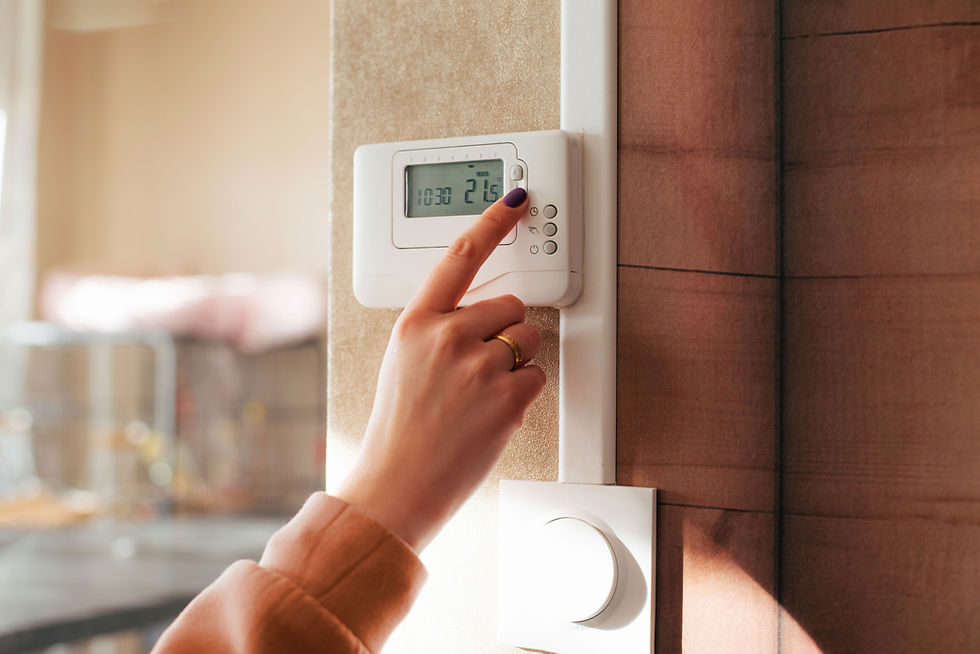7 Genius Ways to Keep Your Home Dust-Free (You’ll Wish You Knew Sooner!)
- Clean Air HVAC Care
- Feb 19
- 4 min read
Dust is an inevitable part of life, but controlling it is essential for a cleaner home and healthier indoor air. We’re about to tackle 7 ways to keep your home dust-free, that anyone can do! Dust particles can contain a variety of allergens, including pet dander, pollen, and even microscopic pollutants that may aggravate asthma and allergies. At CleanAir HVAC Care, we’re dedicated to helping you create a dust-free, fresh home environment with practical tips and HVAC solutions.
Let’s dive in.

Why It’s Important:
Your HVAC system’s air filters are the first line of defense against airborne dust. High-efficiency filters capture smaller dust particles, helping reduce the amount that settles on surfaces.
Tip for Effective Dust Control:
Use high-quality HEPA filters if your HVAC system is compatible, and change filters every 1-3 months to maintain good airflow and efficient dust capture.
Pro Tip:
If you’re looking for a more advanced solution, consider installing an air filtration system that works alongside your HVAC for even better dust control.
2. Vacuum and Dust Strategically
Why It’s Important:
Dust settles easily on floors and furniture, especially in carpeted areas. Using a vacuum with a HEPA filter ensures you’re capturing dust and not redistributing it.
Tip for Effective Dust Control:
Vacuum carpets, rugs, and upholstery at least once a week. For hard floors, a microfiber mop works best. Always dust surfaces before vacuuming so you can capture airborne particles that might have settled.
Pro Tip:
Dusting with a damp microfiber cloth instead of a dry duster traps more particles, reducing how much becomes airborne and resettles elsewhere.
3. Keep Windows Closed on High-Pollen Days
Why It’s Important:
Pollen, a major component of dust, can easily enter your home through open windows, especially during spring and fall. Keeping windows closed on high-pollen days helps reduce dust buildup indoors.
Tip for Effective Dust Control:
Check local pollen counts and avoid opening windows during peak pollen hours, typically early mornings. Rely on air conditioning for ventilation and use air purifiers to circulate cleaner air.
Pro Tip:
Using an air purifier with a HEPA filter can further reduce pollen and dust particles, creating a cleaner, allergen-free environment.

4. Declutter and Dust-Proof Your Home
Why It’s Important:
Clutter can make dust control a challenge. The more items there are, the more surfaces dust has to settle on, and harder it becomes to keep dust-free.
Tip for Effective Dust Control:
Minimize decorations and reduce clutter where dust collects, such as open shelves and tabletops. Opt for closed storage whenever possible, and keep dust-sensitive items like books and magazines in cabinets or drawers.
Pro Tip:
Using anti-static spray on surfaces can help repel dust, making it easier to keep your home dust-free for longer.
5. Invest in High-Quality Doormats and Clean Them Regularly
Why It’s Important:
Much of the dust that enters a home is carried in from the outside. A high-quality doormat catches dust, dirt, and pollen at the door before they enter your home.
Tip for Effective Dust Control:
Place a sturdy doormat both outside and inside each entrance to your home, and clean or shake them out weekly. Encourage guests and household members to wipe their feet thoroughly before coming inside.
Pro Tip:
If possible, implement a no-outdoor-shoes policy indoors to prevent tracking in dust and dirt from outside.
6. Consider Adding Indoor Plants for Dust Control
Why It’s Important:
Certain indoor plants, like peace lilies and spider plants, can act as natural dust filters by trapping airborne particles on their leaves. They also improve air quality by adding humidity, which reduces dust in dry environments.
Tip for Effective Dust Control:
Choose low-maintenance indoor plants and regularly wipe their leaves to prevent dust buildup, which helps them continue to filter the air effectively.
Pro Tip:
Grouping plants together in one area can enhance the air-filtering effect and create a natural, aesthetic dust-control zone in your home.
7. Schedule Regular HVAC Maintenance and Equipment Cleanings
Why It’s Important:
Your HVAC system circulates air throughout your home, so dust can quickly accumulate in ducts, registers, and vents if they’re not cleaned. Regular maintenance and equipment or system cleaning are key to minimizing dust and improving airflow.
Tip for Effective Dust Control:
Schedule an HVAC inspection at least once a year and discuss options for duct cleaning if dust buildup is significant. Clean equipment improves system efficiency, reduces dust, and helps you maintain a cleaner home.
Pro Tip:
At CleanAir HVAC Care, we offer professional inspections and cleaning services to keep your HVAC running efficiently and dust levels down. Before scheduling an air duct cleaning, we highly recommend getting it thoroughly inspected by a professional and have them show you the damage/mold/blockage.

Conclusion
A few adjustments can make a huge difference in controlling dust and keeping your indoor air fresh. By following these tips, you can breathe easier and enjoy a cleaner, healthier home. For more detailed insights into improving air quality, explore our blog for additional tips, or reach out to CleanAir HVAC Care. Whether you’re interested in regular HVAC maintenance, duct cleaning, or high-quality air filtration, we’re here to help. Schedule an inspection or connect with us via chat to learn more.
_edited_edited.png)


